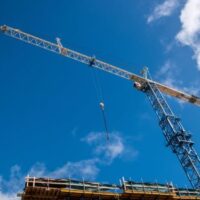Crane Injuries on Construction Sites

Most large-scale construction sites require cranes to perform certain types of building and repair work. For construction workers in Maryland, cranes are among the more dangerous types of equipment on construction sites, and they are often cited in serious and deadly accidents that occur. There are different types of cranes that can be used on construction sites, and various ways in which cranes can be involved in accidents and injuries. Regardless of the type of crane or the manner of the crane accident, it is important for Maryland construction workers and their families to know that crane injuries are often compensable through the Maryland workers’ compensation system. As such, you may be able to seek benefits to pay for medical care, lost wages, disability, and more.
In the meantime, our Maryland construction accident lawyers can tell you more about cranes, crane safety, and common accidents and injuries that occur.
Getting the Facts About Crane Accidents and Injuries
Cranes are often cited in serious and fatal workplace accidents, especially in construction injuries and deaths. According to the Bureau of Labor Statistics (BLS), more than 40 percent of all crane accidents happen on construction sites, and almost 60 percent of these accidents are struck-by accidents. In other words, a construction worker is struck by an object or materials that fall from a crane or are being transported by a crane in a majority of crane accidents. In fatal crane accidents, the crane operator is the worker who suffers deadly injuries in more than 20 percent of reported cases. The most commonly reported crane accidents include:
- Struck-by accidents, from falling materials or loads;
- Struck-by accidents, from being hit by the crane;
- Falls from cranes; and
- Being run over by a crane.
There are various safety requirements from the Occupational Safety and Health Administration (OSHA) designed to prevent crane accidents in Maryland and throughout the country. Those safety requirements include mandatory operator certification requirements, employees who have been trained in rigging and signaling, and safety training for construction workers performing tasks on sites where cranes are in operation.
Why Cranes on Construction Sites Pose Injury Risks
Why are cranes involved in construction accidents so frequently? Understanding more about these enormous and heavy machines can help to clarify why they can be so dangerous.
According to Maxim Crane Works, cranes can be classified as either static cranes that are permanently installed on a construction site until the job is finished, or mobile cranes that can be moved around construction sites. They are stories-high machines that are designed to lift extremely heavy loads and to reach very high-up locations on buildings under construction or repair. Mobile cranes weigh anywhere from 10 tons (or 20,000 pounds) up to about 400 tons (or 800,000 pounds), and they can typically lift loads weighing between 10,000 and 60,000 pounds.
Contact a Maryland Construction Worker Injury Attorney
Were you injured in a crane accident while working on a construction site? Or was a spouse or parent seriously injured or killed in a construction site crane accident? It is critical to seek legal advice as soon as you can. One of the experienced Maryland construction worker injury attorneys at the Law Offices of Steinhardt, Siskind and Lieberman, LLC is here to assist you with your workers’ compensation claim, whether you are seeking benefits for yourself or death benefits after losing a loved one in a workplace accident. Contact us today for help with your workers’ compensation case or to appeal a denial of benefits.
Sources:
bls.gov/iif/factsheets/fatal-occupational-injuries-cranes-2011-17.htm
osha.gov/cranes-derricks
